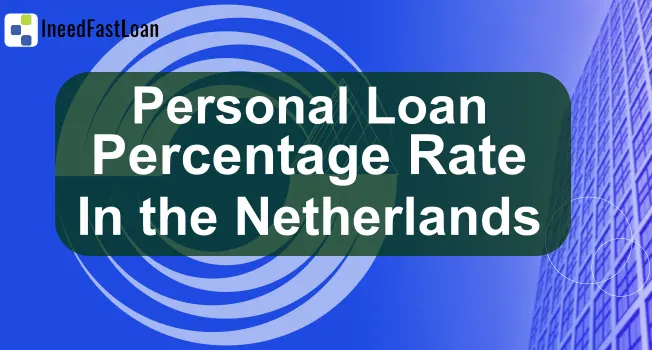How to Check Personal Loan Percentage Rate in the Netherlands

Understanding personal loan percentage rates is crucial for anyone considering taking out a loan. In the Netherlands, the personal loan market is diverse and competitive, offering various options to suit different financial needs and circumstances. This guide will provide comprehensive insights into how to check personal loan percentage rates in the Netherlands, ensuring you make an informed decision when seeking financial assistance.
Personal Loan Percentage Rates in Netherlands
Personal loan percentage rates, often referred to as interest rates, represent the cost of borrowing money. These rates can vary significantly depending on various factors, including the loan amount, term, borrower’s credit score, and the lender’s policies. In the Netherlands, interest rates on personal loans are influenced by the European Central Bank’s monetary policies, economic conditions, and market competition.
Fixed vs. Variable Personal Loan Percentage Rates
In the Dutch market, personal loans typically come with either fixed or variable interest rates:
- Fixed Interest Rates: As the name suggests, fixed interest rates remain constant throughout the loan term. This stability allows borrowers to plan their repayments with certainty, as the monthly installments will not change.
- Variable Interest Rates: Variable interest rates can fluctuate based on market conditions. While they may initially be lower than fixed rates, they carry the risk of increasing over time, which can lead to higher monthly payments.
Annual Percentage Rate (APR) Personal Loan Percentage Rate
The Annual Percentage Rate (APR) is a broader measure of the cost of borrowing money. It includes the interest rate and any additional fees or charges associated with the loan. In the Netherlands, lenders are required by law to disclose the APR to ensure transparency and help borrowers compare different loan offers effectively.
Factors Influencing Personal Loan Percentage Rates
Several factors influence the personal loan percentage rates in the Netherlands:
- Credit Score: Your credit score plays a significant role in determining the interest rate you’ll receive. A higher credit score indicates lower risk to lenders, often resulting in lower interest rates.
- Loan Amount and Term: The amount you wish to borrow and the loan term can impact the interest rate. Typically, larger loan amounts and shorter terms come with lower interest rates.
- Income and Employment Stability: Lenders assess your income and employment stability to gauge your ability to repay the loan. Stable employment and a steady income can lead to more favorable interest rates.
- Debt-to-Income Ratio: This ratio compares your monthly debt payments to your monthly income. A lower debt-to-income ratio can improve your chances of securing a lower interest rate.
- Lender Policies: Different lenders have varying criteria and policies, affecting the interest rates they offer. Shopping around and comparing multiple lenders can help you find the best rate.
How to Check Personal Loan Percentage Rates in the Netherlands
Checking personal loan percentage rates in the Netherlands involves a few key steps:
1. Research Online
The internet is a valuable resource for comparing personal loan rates. Many Dutch banks and financial institutions provide online tools and calculators to help you estimate your interest rates based on your specific circumstances. Websites like Bankrate.nl, Independer.nl, and Geld.nl offer comparison tools that allow you to input your loan amount, term, and other details to receive personalized rate quotes.
2. Visit Bank Websites for Personal Loan Percentage Rate
Directly visiting the websites of major Dutch banks and financial institutions can give you detailed information about their loan products and interest rates. Some of the prominent banks in the Netherlands include ING Bank, Rabobank, ABN AMRO, and SNS Bank. These banks typically provide comprehensive information about their personal loan offerings, including interest rates, fees, and repayment terms.
3. Use Loan Comparison Platforms
Loan comparison platforms aggregate loan offers from multiple lenders, allowing you to compare rates and terms side by side. These platforms often have partnerships with various banks and financial institutions, making it easier to find the best deal. Websites like LoanScouter.nl, Finder.com, and TopCompare.nl are popular in the Netherlands for loan comparisons.
4. Contact Lenders Directly
If you prefer a more personalized approach, contacting lenders directly can provide you with specific information tailored to your financial situation. Speaking with a loan officer or financial advisor can help you understand the interest rates and terms available to you based on your credit profile and financial needs.
5. Check with Credit Unions and Online Lenders
In addition to traditional banks, credit unions and online lenders can offer competitive personal loan rates. Credit unions often have more flexible lending criteria and may offer lower rates to their members. Online lenders, such as LendingClub, SoFi, and Zopa, provide convenient online application processes and may offer attractive rates, especially for those with good credit scores.
Tips for Securing the Best Personal Loan Percentage Rate
To secure the best personal loan percentage rate in the Netherlands, consider the following tips:
1. Improve Your Credit Score
Your credit score is a crucial factor in determining the Personal Loan Percentage Rate you’ll receive. Take steps to improve your credit score by paying off existing debts, making timely payments, and reducing your credit card balances. Regularly checking your credit report for errors and disputing any inaccuracies can also help improve your score.
2. Compare Multiple Lenders
Don’t settle for the first loan offer you receive. Comparing multiple lenders and their interest rates can help you find the best deal. Use online comparison tools and visit different bank websites to gather as much information as possible before making a decision.
3. Consider Loan Term and Amount
The loan term and amount can impact the interest rate. Shorter loan terms often come with lower interest rates, but they also mean higher monthly payments. Evaluate your financial situation and choose a loan term that balances affordability with a competitive interest rate.
4. Negotiate with Lenders
Don’t be afraid to negotiate with lenders to secure a better interest rate. If you have a strong credit profile and a stable income, you may have leverage to negotiate for more favorable terms. Be prepared to provide documentation that supports your financial stability and repayment ability.
5. Understand Additional Fees and Charges
When comparing personal loan offers, pay attention to additional fees and charges that may affect the overall cost of the loan. These can include origination fees, prepayment penalties, and late payment fees. Understanding the total cost of the loan, including these additional charges, will help you make an informed decision.
Legal and Regulatory Considerations
In the Netherlands, personal loans are subject to strict regulations to protect consumers. The Dutch Authority for the Financial Markets (AFM) oversees the financial sector and ensures that lenders comply with consumer protection laws. Some key regulatory considerations include:
1. Transparency and Disclosure
Lenders are required to provide clear and transparent information about loan terms, interest rates, fees, and repayment conditions. This includes disclosing the APR, which helps borrowers compare the true cost of different loan offers.
2. Maximum Interest Rate Cap
The Netherlands has a maximum interest rate cap to prevent usurious lending practices. As of 2024, the maximum allowable interest rate on personal loans is set by the Dutch government and is subject to change based on economic conditions and regulatory decisions. Find out about Personal Loan vs. Business Loan: Which is Right For You?
3. Creditworthiness Assessment
Lenders must assess the creditworthiness of borrowers before approving a loan. This involves evaluating the borrower’s income, expenses, credit history, and overall financial situation to ensure they can afford the loan repayments.
4. Consumer Protection Rights
Borrowers in the Netherlands have various consumer protection rights, including the right to early repayment without penalty, the right to withdraw from a loan agreement within 14 days of signing, and the right to receive clear and understandable information about the loan terms.
Common Types of Personal Loans in the Netherlands
Personal loans in the Netherlands come in various forms to suit different financial needs. Understanding the different types of personal loans can help you choose the most appropriate option for your situation:
1. Unsecured Personal Loans
Unsecured personal loans are the most common type of personal loan. These loans do not require collateral and are based on the borrower’s creditworthiness. Interest rates on unsecured loans can vary widely depending on the borrower’s credit score and financial profile.
2. Secured Personal Loans
Secured personal loans require collateral, such as a car or property, to secure the loan. Because the lender has a claim on the collateral in case of default, secured loans typically come with lower interest rates than unsecured loans. However, they carry the risk of losing the collateral if you fail to make payments.
3. Debt Consolidation Loans
Debt consolidation loans are designed to combine multiple debts into a single loan with a lower interest rate. This can simplify repayment and potentially reduce the overall interest paid on the debts. Debt consolidation loans can be secured or unsecured, depending on the lender’s requirements.
4. Revolving Credit
Revolving credit, also known as a line of credit, provides a flexible borrowing option where you can withdraw funds up to a predetermined limit. Interest is only charged on the amount you borrow, and you can repay and redraw funds as needed. Revolving credit typically comes with variable interest rates.
5. Payday Loans
Payday loans are short-term, high-interest loans designed to provide quick cash until your next payday. Due to their high interest rates and fees, payday loans are generally not recommended for long-term borrowing and should only be used in emergency situations.
Steps to Apply for a Personal Loan in the Netherlands
Applying for a personal loan in the Netherlands involves several steps:
1. Determine Your Loan Needs
Before applying for a personal loan, assess your financial needs and determine the loan amount and term that best suits your situation. Consider factors such as the purpose of the loan, your monthly budget, and your ability to repay the loan.
2. Check Your Credit Score
Your credit score will play a significant role in the loan approval process and the interest rate you’ll receive. Obtain a copy of your credit report from a credit bureau such as Experian, Equifax, or TransUnion to check your credit score and review your credit history for any inaccuracies.
3. Gather Required Documentation
Lenders will require various documents to assess your loan application. Commonly required documents include proof of identity (passport or ID card), proof of income (pay stubs or tax returns), bank statements, and proof of residency. Having these documents ready can expedite the application process.
4. Compare Loan Offers
Use online comparison tools and visit lender websites to compare loan offers. Pay attention to interest rates, APRs, fees, and repayment terms. Choose a loan offer that best fits your financial needs and offers competitive terms.
5. Submit Your Application
Once you’ve chosen a lender, complete the loan application process. This may involve filling out an online application form or visiting a branch in person. Provide all required documentation and information accurately to avoid delays in the approval process.
6. Await Approval and Funding
After submitting your application, the lender will review your information and assess your creditworthiness. If approved, you’ll receive a loan offer outlining the terms and conditions. Review the offer carefully before accepting it. Once you accept the offer, the loan funds will be disbursed to your bank account.
Managing Your Personal Loan
Managing your personal loan responsibly is crucial to maintaining your financial health. Here are some tips to help you stay on track:
1. Create a Repayment Plan
Develop a repayment plan that aligns with your monthly budget. Ensure that you make timely payments to avoid late fees and damage to your credit score. Setting up automatic payments can help you stay on top of your loan repayments.
2. Monitor Your Loan Balance
Regularly monitor your loan balance and repayment progress. Most lenders provide online account access where you can track your payments, outstanding balance, and interest charges. Staying informed about your loan status will help you manage your finances more effectively.
3. Avoid Additional Debt
While repaying your personal loan, avoid taking on additional debt unless absolutely necessary. Accumulating more debt can strain your finances and make it challenging to meet your loan obligations.
4. Refinance if Beneficial
If interest rates decrease or your financial situation improves, consider refinancing your personal loan to secure a lower interest rate. Refinancing can reduce your monthly payments and the overall cost of the loan.
5. Seek Financial Advice
If you encounter financial difficulties or have questions about managing your loan, seek advice from a financial advisor. They can provide guidance on budgeting, debt management, and financial planning to help you stay on track.
Conclusion About Personal Loan Percentage Rate
Checking personal loan percentage rates in the Netherlands involves a combination of research, comparison, and understanding of the factors that influence interest rates. By taking the time to evaluate different loan offers and improving your credit profile, you can secure a personal loan with favorable terms that meet your financial needs.
Recommended:
- Student Loans
- Sambakoop Loan Interest Rates
- Cheapest Home Loans
- Renmoney Loan Application
- Payday Loans for Bad Credit
Remember to utilize online tools, visit lender websites, and consider seeking advice from financial professionals to make informed decisions. With careful planning and responsible management, a personal loan can be a valuable financial tool to achieve your goals and improve your financial well-being.
Common question people ask about
Here are common questions people ask about checking personal loan percentage rates in the Netherlands:
-
What factors affect personal loan percentage rates in the Netherlands?
Personal Loan Percentage Rate are influenced by several factors, including your credit score, loan amount, loan term, income and employment stability, and the lender’s policies.
-
How can I compare personal loan rates from different lenders?
You can compare personal loan rates using online comparison tools, visiting bank websites, contacting lenders directly, or using loan comparison platforms that aggregate offers from multiple lenders.
-
What is the difference between fixed and variable interest rates?
Fixed interest rates remain constant throughout the loan term, providing stability in monthly payments. Variable interest rates can fluctuate based on market conditions, potentially leading to lower initial rates but higher risk of rate increases.
-
What is the Annual Percentage Rate (APR), and why is it important?
The APR is a comprehensive measure of the cost of borrowing, including the interest rate and any additional fees or charges. It helps borrowers compare the true cost of different loan offers effectively.
-
How can I improve my chances of getting a lower interest rate on a personal loan?
To improve your chances, work on boosting your credit score, compare multiple lenders, choose an appropriate loan term and amount, negotiate with lenders, and understand any additional fees and charges associated with the loan.
If you have more question about Personal Loan Percentage Rate in the Netherlands, you can leave a comment by using the comment section.






